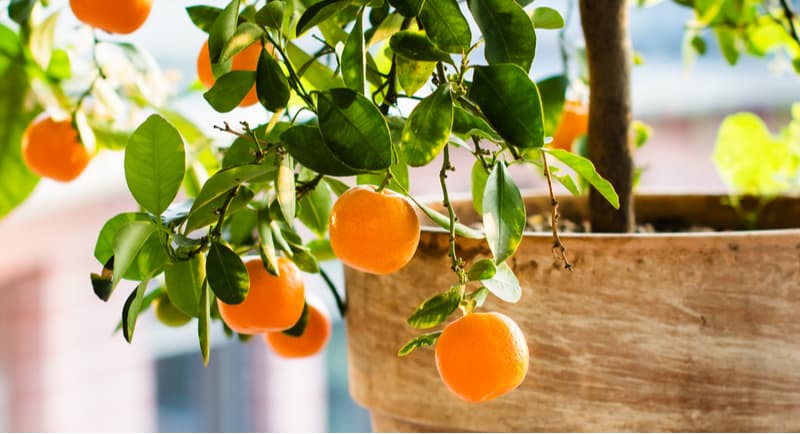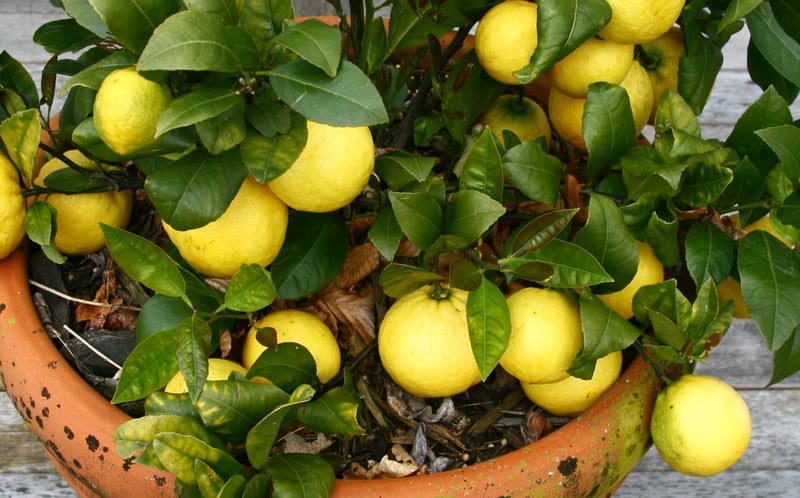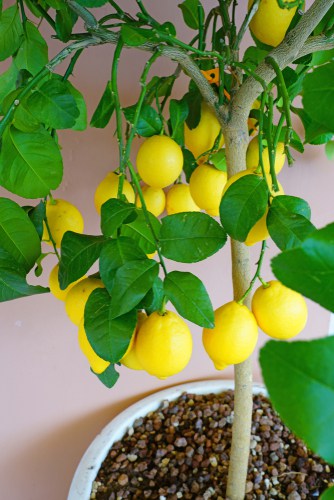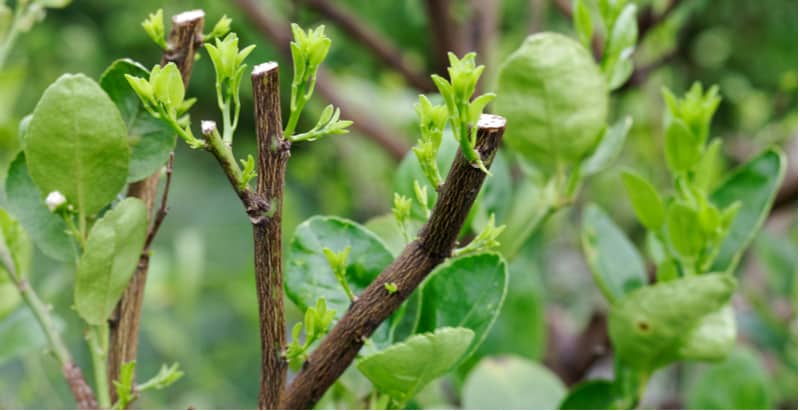Last updated on March 29th, 2022
Our site is reader supported, this means we may earn a small commission from Amazon and other affiliates when you buy through links on our site.
Growing citrus trees in pots and containers is the most effective way to enjoy the bountiful fruit production that citrus trees have to offer for those of us who live in the UK with its less than perfect weather for growing citrus.
Citrus plants don’t naturally survive the colder winter weather of most parts of the UK, but in a container, you have much more control over exposure, soil, sunlight, and more importantly fluctuations in temperature.
Basically, by growing them in pots, you can grow them indoors during the winter as houseplants and then place them outdoors to enjoy over summer once the weather improves and the temperatures begin to feel warmer.
See our top recommended citrus trees for containers

Choosing a container
The nice thing about growing citrus trees in containers is that you can choose just about any material you want. One container material is not better than another, it all comes down to personal preference.
Ceramic, terracotta, or clay pots are going to be heavier and they won’t run the risk of cracking in freezing temperatures as they will be brought indoors over winter although they can be heavy to move around. However, they are the sturdiest so they certainly won’t be blown over by the wind, which is handy for some of the more top-heavy standard types of citrus trees.
Plastic containers, by comparison, are better suited to trees that are grown indoors because they are lightweight and easy to move in and out of the house if your citrus tree will reside part of the year outside and part of the year inside. You can, of course, grow them indoors all year round too. Plastic isn’t as sturdy but they’re usually more than adequate enough and are much more affordable.

Getting the right compost/soil
Citrus plants in pots and containers need a well-balanced potting compost with adequate drainage. Almost any soil will do but most important is the pH level. Make sure you regularly check on the pH level, especially for lemons so that you can control the acidity keeping it between 5.5 and 6.5 pH. To avoid any issues we recommend using a soil-based compost (such as John Innes potting compost) and mix around 25% horticultural grit to improve the drainage. This will ensure the compost can retain moisture, which is important for citrus trees and that it is also free-draining. You can also buy specialised citrus compost too.
When planting in your plant in its pot make sure the containers are a good size with plenty of room around the pot, but be careful not to go too large in one go. Anything larger than that will simply be too big to move around. As a general guide, the container you choose should be one that is between 25% and 50% larger than the root ball of the citrus plant.
Repotting potted citrus trees
As your plant gets bigger, around the 3rd or 4th year it might outgrow the container. The first signs will probably be yellowing leaves and the soil struggling to hold the moisture. When this happens you will need to transplant it into another container that is, again, between 25% and 50% larger than the current root ball.

They need plenty of direct sunlight
Sunlight is incredibly important and the number of hours required is going to average around 6 hours of direct sunlight every day, depending on the citrus plant you have. This should be direct sunlight so when you place your pot or container outside during the summer make sure it’s an area that has access to unfiltered sunlight throughout the day.
It is important to note though that too much sunlight can burn the plant and cause root burn, however, this is not something you need to worry about unless your plant is getting more than 12 hours of direct sunlight.
Overwintering when the weather gets cold
Cold temperatures and not enough light are the last things you want. If they do not get enough light or are exposed to cold temperatures it will hinder the growth and can eventually kill the citrus plant, especially if they get caught in a cold snap.
That is why when weather conditions turn it’s important that you move the container inside or at least to an enclosed patio where it’s protected and kept above freezing. When you move it inside the number of sunlight hours remains just as important. You need to find an area near a window that gets at least six hours of direct sunlight. If there is no such available space in your home you can get a grow light to help offset this until such time the weather changes and your container-grown citrus plant can be moved back outside.
Ideal winter growing temperatures
If you grow lemons trees or limes, you will need to maintain a winter night temperature above 10°C (50°F) with calamondin oranges being able to withstand slightly colder temperatures and Kumquats will even tolerate night time temperatures as low as 7°C (45°F). 
Watering and feeding container grow citrus
Feeding pot grown citrus
For most citrus plants fertiliser is not a requirement for the first year of their growth but after that, you can fertilise on limited occasions. Once every month when the plant is growing in spring and summer, right after you transplant the mature citrus tree to another container, and once during winter should be sufficient. You can actually buy summer and winter citrus feeds too.
Keeping the soil of citrus trees in containers moist
Watering is contingent upon where the plant is. If you are growing your citrus tree indoors it doesn’t need to be watered as frequently as a plant you are growing outdoors. Similarly, when the weather gets significantly warmer and humid you should increase the frequency you water your plants and decrease accordingly when the weather gets colder.
Root rot is a risk with citrus when overwatering if you let them get waterlogged. Ideally, you want to keep the soil moist but not soggy and reduce watering during the winter, letting the surface of the soil dry before watering again.

Pruning
Pruning is a minimal requirement when maintaining citrus trees in the UK because they are usually pot grown and so don’t grow too large. When you are growing them in pots and containers you only really have to worry about pruning in order to control the growth and shape. If you maintain the plant in terms of food and sun and soil, you will get an ample production of fruit without any pruning.
That being said, if you want to encourage more lateral branches as opposed to the taller central branches you can always cut them off directly above the leaf node. This is something that is best done in the earlier stages of the plant development so that you can train them properly. Leggy plants will respond well to hard pruning if needed.
You can see out detailed guide on pruning citrus trees by clicking here
Overall, these steps and tips apply to grow any type of citrus in a container or pot but once you decide on the specific type of citrus tree and the variety, whether it be a Meyer lemon, lime tree or citrus orange tree, it’s important that you look into any specific requirements for that variety so that you can provide the best possible growing conditions.
Image credits – Shutterstock.com


